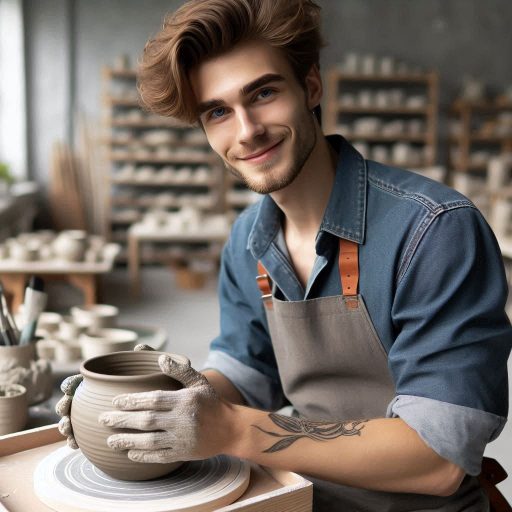Introduction
Building a successful ceramic art studio involves careful planning and execution.
A well-designed studio not only enhances creativity but also ensures productivity.
Crafting beautiful ceramics requires a space that supports your artistic vision and practical needs.
Proper planning is essential when setting up a ceramic studio.
This involves choosing the right location, designing an efficient layout, and investing in quality equipment.
Each decision impacts your workflow and creative output. Effective execution ensures that your studio remains functional and inspiring.
In this blog post, we will guide you through the essential steps to build a successful ceramic art studio.
We will cover how to select the perfect location, design an efficient workspace, and equip your studio with the necessary tools.
We will also discuss tips for maintaining a clean and organized environment, which is crucial for both safety and creativity.
By following these steps, you will create a studio that not only meets your artistic needs but also enhances your productivity.
With the right planning and execution, your ceramic art studio will become a thriving space where creativity can flourish.
Define Your Goals and Vision
When starting a ceramic art studio, it is crucial to define your goals and vision to set a clear direction for your business.
This will provide you with a roadmap to success and ensure that you are working towards a specific purpose.
Identify the purpose and goals of your ceramic art studio
Before launching your studio, take the time to understand why you are starting this business.
Are you looking to create a space for artistic expression, provide art education to the community, or generate income from selling your ceramic creations?
By identifying your purpose, you can establish meaningful goals that align with your mission.
Develop a clear vision for what you want to achieve with your studio
Having a vision statement for your ceramic art studio will help you stay focused and motivated.
Your vision should outline the future you aspire to create through your studio, such as becoming a renowned ceramics workshop, fostering creativity in your community, or showcasing your artwork in galleries worldwide.
Keep this vision at the forefront of your mind as you build your studio.
Determine your target audience and market niche
Understanding your target audience is essential for the success of your ceramic art studio.
Transform Your Career Today
Unlock a personalized career strategy that drives real results. Get tailored advice and a roadmap designed just for you.
Start NowConsider who is most likely to be interested in your offerings – whether it’s art enthusiasts, hobbyists, or collectors.
By defining your market niche, you can tailor your products, services, and marketing efforts to cater to the specific needs and preferences of your target customers.
This will help you attract and retain loyal clients who resonate with your artistic style and brand.
In fact, defining your goals and vision is the first step towards building a successful ceramic art studio.
By setting clear objectives, establishing a compelling vision, and identifying your target audience and market niche, you can create a thriving business that fulfills your artistic ambitions and resonates with your customers.
Read: How to Turn Your Digital Art into NFTs
Create a Business Plan
Detailed business plan that includes financial projections, marketing strategies, and operational procedures
A robust business plan is vital for building a successful ceramic art studio.
Start by outlining a comprehensive plan that covers financial projections, marketing strategies, and operational procedures.
This blueprint will guide your studio’s growth and ensure its sustainability.
Begin with financial projections.
Calculate startup costs, including equipment, materials, and rent.
Estimate ongoing expenses such as utilities, wages, and maintenance.
Project your revenue streams, including sales from your art, classes, and workshops.
This financial overview will help you secure funding and manage your budget effectively.
Next, develop marketing strategies to attract customers.
Identify your target audience, such as art collectors, hobbyists, or students.
Create a compelling brand identity with a memorable logo and engaging website.
Utilize social media platforms to showcase your work and connect with potential clients.
Plan promotional activities, such as exhibitions or special discounts, to boost visibility and sales.
Operational procedures are crucial for smooth studio management.
Transform Your Career Today
Unlock a personalized career strategy that drives real results. Get tailored advice and a roadmap designed just for you.
Start NowEstablish clear processes for creating, storing, and selling your ceramic pieces.
Set up a workflow for handling customer orders and managing inventory.
Define roles and responsibilities if you have staff or collaborators.
Ensure compliance with local regulations and safety standards.
Set realistic goals and timelines for reaching key milestones
Set realistic goals and timelines to track your progress.
Define short-term milestones, like completing your first set of products or holding your first workshop.
Establish long-term objectives, such as expanding your product line or reaching a specific revenue target.
Regularly review and adjust your goals based on performance and market changes.
Seek input and advice from experienced professionals in the ceramics industry
Lastly, seek input and advice from experienced professionals in the ceramics industry.
Network with other ceramic artists and studio owners to gain insights.
Join industry associations or attend conferences to stay informed about trends and best practices.
Their guidance can provide valuable perspective and help you avoid common pitfalls.
Creating a solid business plan sets the foundation for a successful ceramic art studio.
It will guide your operations, marketing efforts, and financial management, paving the way for growth and success.
Read: Skills Needed to Become a Ceramic Artist
Choose the Right Location
Select a suitable location for your studio that is accessible to your target audience
Choosing the right location for your ceramic art studio is crucial to its success.
You want to be easily accessible to your target audience, whether that’s art enthusiasts, students, or collectors.
Consider a location with high foot traffic, such as a bustling downtown area or an arts district.
This will help attract potential customers and drive more business to your studio.
Consider factors such as foot traffic, proximity to suppliers, and zoning regulations
In addition to foot traffic, proximity to suppliers is also important.
Transform Your Career Today
Unlock a personalized career strategy that drives real results. Get tailored advice and a roadmap designed just for you.
Start NowYou’ll need easy access to clay, glazes, tools, and other materials to keep your studio running smoothly.
Being close to suppliers can help reduce transportation costs and save you time when restocking on supplies.
Another factor to keep in mind when choosing a location is zoning regulations.
Make sure the location you choose allows for a ceramics studio to operate.
Some areas may have restrictions on the types of businesses that can operate in certain zones, so it’s important to do your research before signing a lease.
Create a welcoming and inspiring space for your clients and artists
Once you’ve found the perfect location for your studio, it’s important to create a welcoming and inspiring space for your clients and artists.
Consider the layout of the studio, the lighting, and the overall atmosphere you want to create.
Make sure the space is clean, organized, and aesthetically pleasing.
This will help set the tone for creativity and productivity in your studio.
By carefully choosing the right location for your ceramic art studio and creating a welcoming environment, you’ll be setting yourself up for success and attracting customers and artists to your space.
Read: Skills Needed to Become a Ceramic Artist
Invest in Quality Equipment and Supplies
To build a successful ceramic art studio, investing in quality equipment and supplies is essential.
Here‘s how to make the best choices:
Purchase high-quality ceramics equipment and materials that meet your artistic needs
Begin by selecting high-quality ceramics equipment that suits your artistic vision.
This includes kilns, wheels, and worktables.
Ensure the kiln can handle the temperatures required for your pieces.
A reliable potter’s wheel should offer smooth, consistent rotation.
Opt for durable, well-crafted materials that enhance your work’s quality and longevity.
Invest in tools and technology that will enhance your creative process
Invest in tools that will elevate your creative process.
Quality tools like carving instruments, molds, and brushes are crucial.
Transform Your Career Today
Unlock a personalized career strategy that drives real results. Get tailored advice and a roadmap designed just for you.
Start NowTechnology such as digital scales and temperature controllers can improve precision.
Look for innovations like electric kilns or computerized glaze mixers.
These tools and technologies not only streamline your workflow but also expand your artistic possibilities.
Consider the long-term value and durability of your equipment choices
When choosing equipment, consider long-term value and durability.
High-quality items may have a higher initial cost but will save money over time.
Durable equipment withstands frequent use and reduces replacement costs.
Think about the maintenance and repair needs of your tools.
Investing in reliable, long-lasting equipment ensures your studio remains productive and efficient for years.
In summary, investing in top-notch ceramics equipment and supplies is crucial for a successful studio.
Choose high-quality items that meet your artistic needs, integrate tools and technology to enhance creativity, and prioritize durability for long-term value.
This strategic approach will set the foundation for a thriving ceramic art practice.
Reda: Using Social Media to Promote Digital Art

Develop a Strong Online Presence
Build a professional website and social media profiles to showcase your work and attract clients
Building a successful ceramic art studio requires more than just talent; it demands a robust online presence.
Start by creating a professional website.
Ensure it showcases your portfolio with high-quality images of your work.
Include an easy-to-navigate gallery and detailed descriptions of each piece.
Add a blog or news section to update visitors on new projects, events, and studio news.
Create engaging content that highlights your artistic process and promotes your studio
Next, establish social media profiles on platforms where your target audience is active.
Instagram and Facebook are ideal for visual content.
Use these platforms to share your art, behind-the-scenes glimpses of your creative process, and updates about your studio.
Transform Your Career Today
Unlock a personalized career strategy that drives real results. Get tailored advice and a roadmap designed just for you.
Start NowEngage with followers by responding to comments and messages promptly.
Regularly post engaging content to keep your audience interested and invested.
Collaborate with influencers and partners to expand your reach and visibility
Content creation is crucial for building your brand.
Share videos or time-lapse footage of your artistic process.
Highlight the techniques you use and the inspiration behind your pieces.
Offer insights into your creative journey, showing potential clients what sets your work apart.
Create posts that invite your audience to participate, such as polls or questions about their preferences.
Collaborate with influencers and partners to enhance your visibility.
Identify influencers who share an interest in art or ceramics and reach out for potential partnerships.
They can help promote your studio to their followers, expanding your reach.
Partner with local businesses or art institutions to host joint events or exhibitions.
Such collaborations can attract a broader audience and enhance your credibility.
By focusing on these strategies, you can build a strong online presence that not only showcases your work but also attracts clients and expands your reach.
An effective online presence will help you connect with art enthusiasts and grow your ceramic art studio.
Offer Diverse Services and Classes
Develop a Range of Services and Classes to Cater to Different Interests and Skill Levels
To build a successful ceramic art studio, offer a variety of services and classes.
Start by assessing your community’s interests and needs.
Design classes for beginners, intermediates, and advanced students.
Include workshops on hand-building, wheel-throwing, glazing techniques, and kiln firing.
Offering private lessons or group classes allows flexibility.
Provide options for different schedules, including evening and weekend sessions.
Transform Your Career Today
Unlock a personalized career strategy that drives real results. Get tailored advice and a roadmap designed just for you.
Start NowThis variety ensures you meet diverse interests and skill levels.
Provide Opportunities for Clients to Learn and Engage with the Ceramic Arts
Engagement is key to a thriving studio.
Create interactive learning opportunities beyond standard classes.
Organize demonstrations where clients can watch and ask questions.
Offer online tutorials and video lessons for those who prefer self-paced learning.
Create projects that clients can work on at home.
Engage clients through hands-on activities and creative challenges.
Provide resources like instructional books and guides.
These opportunities enhance the learning experience and foster a deeper connection with ceramic arts.
Host Events and Workshops to Promote Community Engagement and Collaboration
Community involvement strengthens your studio’s presence.
Host regular events such as open studios, exhibitions, and pottery sales.
Organize collaborative workshops where clients can work on joint projects.
Invite local artists for guest lectures or collaborative sessions.
Create themed workshops to celebrate holidays or special occasions.
These events not only promote the studio but also build a supportive community.
Encourage clients to invite friends and family, broadening your audience.
Active community engagement fosters a loyal client base and attracts new participants.
All in all, a successful ceramic art studio thrives by offering diverse classes and services, engaging clients through learning opportunities, and fostering community through events and workshops.
This approach creates a dynamic and inclusive environment, ensuring long-term success.
See Related Content: Tips for Eco-Friendly Packaging Design Solutions
Transform Your Career Today
Unlock a personalized career strategy that drives real results. Get tailored advice and a roadmap designed just for you.
Start NowCultivate a Creative and Supportive Environment
Building a successful ceramic art studio involves more than just physical space and equipment.
Cultivating a creative and supportive environment is crucial. Here‘s how to achieve it:
Foster a Positive and Inclusive Culture
Create a welcoming atmosphere where every artist feels valued and respected.
Encourage open communication and mutual support among artists.
Celebrate diverse artistic styles and approaches.
By promoting inclusivity, you foster an environment where creativity can flourish. Recognize and reward effort and innovation.
This positive reinforcement motivates artists to push their boundaries and experiment.
Provide Mentorship and Support
Offer guidance to emerging artists and students.
Experienced artists can share their skills and insights through structured mentorship programs.
Host workshops and regular critique sessions to provide constructive feedback.
This support helps new artists refine their techniques and gain confidence.
Encourage collaboration among artists, allowing them to learn from each other.
Building a community where knowledge is freely shared accelerates growth and development.
Create an Inspiring Space
Design your studio to be visually stimulating and conducive to creativity.
Use natural light to brighten the workspace and enhance mood.
Decorate with inspiring artworks and thoughtful details.
Ensure that the studio layout is functional and comfortable.
Provide ample space for creative exploration and experimentation.
Create areas for relaxation and reflection to recharge and inspire.
An environment that feels both creative and nurturing empowers artists to express themselves fully.
Transform Your Career Today
Unlock a personalized career strategy that drives real results. Get tailored advice and a roadmap designed just for you.
Start NowBy focusing on these elements, you build a studio where creativity thrives.
A positive and supportive atmosphere not only enhances individual growth but also strengthens the collective spirit of the artistic community.
This approach transforms your studio into a vibrant hub of creativity and innovation.
Conclusion
Building a successful ceramic art studio requires dedication, planning, and a passion for the craft.
It’s essential to have a clear vision, a solid business plan, and a commitment to quality.
Throughout this blog post, we have discussed the importance of creating a welcoming and inspiring space for your studio, investing in quality equipment, and building a strong online presence through social media and a professional website.
Remember to stay creative, flexible, and open to new ideas.
Make sure to network with other artists, attend workshops, and continuously learn and grow in your craft.
Resilience is key in the face of challenges, and your passion for ceramics will drive you towards success.
Now is the time to take action and start planning for your own ceramic art studio.
Use the tips and strategies outlined in this post to guide you on your journey.
Believe in yourself, stay true to your vision, and the results will follow.
Embrace creativity, resilience, and passion ‘ these qualities will set you apart in the ceramics industry and help you achieve your goals.
With dedication and hard work, you can build a thriving ceramic art studio that reflects your unique artistic vision and brings joy to others.




